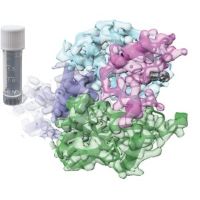Specification
| Description | Recombinant protein from the full-length sequence of Homo sapiens G protein pathway suppressor 2 (GPS2) (NM_004489). |
| Organism | Homo sapiens (Human) |
| Expression Host | Human Cells |
| Tag Info | His or DYKDDDDK. Please contact us if you need further information or require specific designed tag. |
| Purity | Greater than 90% by SDS-PAGE gel |
| Uniprot ID | Q13227 |
| Entry Name | GPS2_HUMAN |
| Gene Names | GPS2 |
| Alternative Gene Names | |
| Alternative Protein Names | G protein pathway suppressor 2 (GPS-2) |
| Application | Antigens, Western, ELISA and other in vitro binding or in vivo functional assays, and protein-protein interaction studies; For research & development use only! |
| Buffer | Purified protein formulated in a sterile solution of PBS buffer, pH7.2, without any preservatives |
| Endotoxin | Endotoxin level is < 0.1 ng/µg of protein (<1EU /µg) |
| Length | 327 |
| Molecular Weight(Da) | 36689 |
| Protein Sequence | (The sequence of expressed protein may have some variation from the sequence shown below. Please contact us for the exact sequence.) MPALLERPKLSNAMARALHRHIMMERERKRQEEEEVDKMMEQKMKEEQERRKKKEMEERMSLEETKEQILKLEEKLLALQEEKHQLFLQLKKVLHEEEKRRRKEQSDLTTLTSAAYQQSLTVHTGTHLLSMQGSPGGHNRPGTLMAADRAKQMFGPQVLTTRHYVGSAAAFAGTPEHGQFQGSPGGAYGTAQPPPHYGPTQPAYSPSQQLRAPSAFPAVQYLSQPQPQPYAVHGHFQPTQTGFLQPGGALSLQKQMEHANQQTGFSDSSSLRPMHPQALHPAPGLLASPQLPVQMQPAGKSGFAATSQPGPRLPFIQHSQNPRFYHK |
Background
| Function | FUNCTION: Key regulator of inflammation, lipid metabolism and mitochondrion homeostasis that acts by inhibiting the activity of the ubiquitin-conjugating enzyme UBE2N/Ubc13, thereby inhibiting 'Lys-63'-linked ubiquitination (By similarity). In the nucleus, can both acts as a corepressor and coactivator of transcription, depending on the context (PubMed:24943844). Acts as a transcription coactivator in adipocytes by promoting the recruitment of PPARG to promoters: acts by inhibiting the activity of the ubiquitin-conjugating enzyme UBE2N/Ubc13, leading to stabilization of KDM4A and subsequent histone H3 'Lys-9' (H3K9) demethylation (By similarity). Promotes cholesterol efflux by acting as a transcription coactivator (PubMed:19481530). Acts as a regulator of B-cell development by inhibiting UBE2N/Ubc13, thereby restricting the activation of Toll-like receptors (TLRs) and B-cell antigen receptors (BCRs) signaling pathways (By similarity). Acts as a key mediator of mitochondrial stress response: in response to mitochondrial depolarization, relocates from the mitochondria to the nucleus following desumoylation and specifically promotes expression of nuclear-encoded mitochondrial genes (PubMed:29499132). Promotes transcription of nuclear-encoded mitochondrial genes by inhibiting UBE2N/Ubc13 (PubMed:29499132). Can also act as a corepressor as part of the N-Cor repressor complex by repressing active PPARG (PubMed:19858209, PubMed:24943844). Plays an anti-inflammatory role in macrophages and is required for insulin sensitivity by acting as a corepressor (By similarity). Plays an anti-inflammatory role during the hepatic acute phase response by interacting with sumoylated NR1H2 and NR5A2 proteins, thereby preventing N-Cor corepressor complex dissociation (PubMed:20159957). In the cytosol, also plays a non-transcriptional role by regulating insulin signaling and pro-inflammatory pathways (By similarity). In the cytoplasm, acts as a negative regulator of inflammation by inhibiting the proinflammatory TNF-alpha pathway; acts by repressing UBE2N/Ubc13 activity (By similarity). In the cytoplasm of adipocytes, restricts the activation of insulin signaling via inhibition of UBE2N/Ubc13-mediated ubiquitination of AKT (By similarity). Able to suppress G-protein- and mitogen-activated protein kinase-mediated signal transduction (PubMed:8943324). Acts as a tumor-suppressor in liposarcoma (PubMed:27460081). {ECO:0000250|UniProtKB:Q921N8, ECO:0000269|PubMed:19481530, ECO:0000269|PubMed:19858209, ECO:0000269|PubMed:20159957, ECO:0000269|PubMed:24943844, ECO:0000269|PubMed:27460081, ECO:0000269|PubMed:29499132, ECO:0000269|PubMed:8943324}.; FUNCTION: (Microbial infection) Required for efficient replication of hepatitis C virus (HCV) by promoting the interaction between VAPA and HCV virus protein NS5A. {ECO:0000269|PubMed:24223774}. |
| Pathway | |
| Protein Families | |
| Tissue Specificity | Widely expressed. {ECO:0000269|PubMed:8943324}. |
QC Data
| Note | Please contact us for QC Data |
| Product Image (Reference Only) |  |

